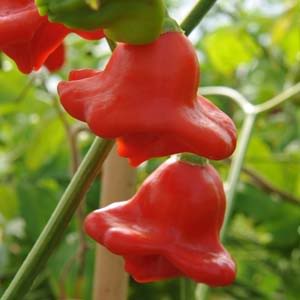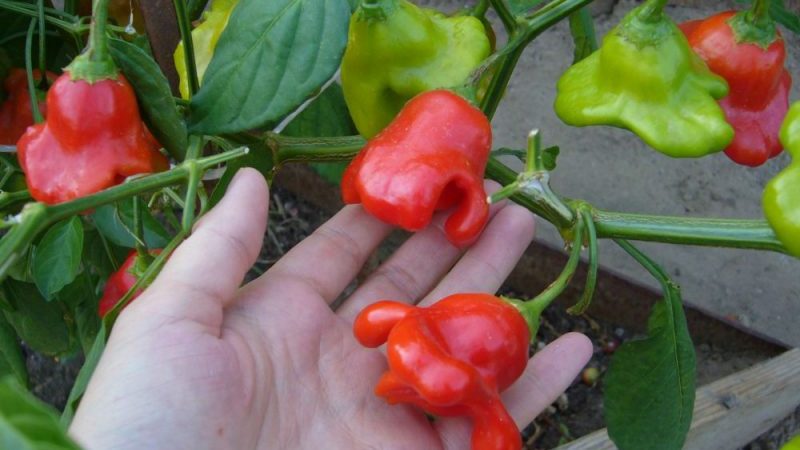Hybrid pepper-tree "Octopus New Year F1": reviews, cultivation and use of the crop
The pepper tree is a plant that combines healthy fruits with an unusual appearance. The culture was the result of domestic selection and is not only a prolific hybrid, but also a decorative decoration of a plot, balcony or greenhouse.
You will learn more about the unique hybrid Octopus New Year's F1, its distinctive features, cultivation and care features in this article.
The content of the article
What is this pepper
Pepper-tree Octopus New Year's F1 is so named because it is capable of braiding any support in the process of growth, like a sea clam.
Characteristics and description of the hybrid

A medium-late hybrid, can grow to the size of a tree: within six months, with proper care, it reaches a height of 3 to 5 m. Pepper ripens within 120-130 days from the moment the first shoots appear.
The height of the plant requires that it has something to rely on: it can be a decorative trellis or other support. She will not let the giant break under the weight of its own fruits and branches.
Distinctive features
The pepper tree is the result of the work of Russian breeders. Crossing different varieties peppers allowed to create a culture with an unusual appearance, while maintaining a high yield. However, you will not be able to collect seeds for growing a plant yourself, since this is a hybrid. Seed material will have to be bought every time.
Reference! The hybrid is grown at home, if there is enough space, or in the garden. In a greenhouse, pepper will give maximum growth and yield, and in open ground it will grow fully only in a warm climate.
Fruit characteristics and yield
The hybrid produces fruits of an unusual shape: they look like bells. Their number is large: from one plant, with proper care, you can remove from 300 to 500 peppers. The fruits are medium-sized - about 25 g with a length of 3-4 cm.
The fruits turn from green to bright red in a week. Unripe peppers sweet, and in the process of ripening, they acquire a sharpness and aroma along with a blush.
Reference! The more light the pepper tree has, the more pungent the fruits will be.
The pulp of the peppers is dense, with medium pungency. The seeds inside the fruit are more pungent.
The fruits are widely used in cooking:
- fresh - soups, meat dishes, salads, sauces;
- pickling entirely with stalks;
- use as an integral part of blanks;
- freezing.
Preparation for growing
Before you start planting seedlings, you need to purchase seeds, prepare the soil and containers.
Purchased seeds that do not need dressing are germinated. To do this, they are wrapped in a damp cloth, which is soaked in an aqueous solution of wood ash: for 1 liter of hot water, 2 tbsp. l. ash (the liquid is infused for a couple of days). The seeds are then placed in a warm place.
Attention! The soaking procedure is optional, but desirable - this way the seeds will germinate faster.
Next, prepare the soil. There are two ways - buy a finished product or make a primer yourself.
For self-preparation, take 1 bucket of garden soil mixed with humus (1 bucket), sand (1/3 bucket) and ash (0.5 l).
The prepared soil is disinfected:
- keep in the oven for up to 40 minutes, setting the temperature to 80-90 ° C;
- pour boiling water over;
- watered with a solution of potassium permanganate of a dark pink hue;
- kept in a steam bath for about 40 minutes.
Important! After disinfection, the soil is given 2 weeks so that it is colonized with beneficial microorganisms.
Then the soil is placed in containers (pots, plastic glasses) and moistened before planting the seeds.
How to grow seedlings
Correct planting of seeds and proper care for them is the key to the formation of a strong, hardy plant.
Reference! Pepper does not tolerate transplantation, so it is advisable to do without picking so as not to injure the delicate root system of the plant.
Planting pepper
The hybrid is planted from late February to early March... The seeds are placed in the holes to a depth of no more than 1 cm, covering them with earth. The container with the planted seeds is covered with foil or glass. In this form, future peppers are kept at a temperature of 25 to 30 ° C until the moment when shoots appear. Seedlings require periodic watering and feeding.
If the peppers were planted in the same container, a pick is made - but only after the seedlings have formed a pair of true leaves.
2 weeks before planting in the soil, the seedlings begin to harden. First, a window is opened in the room, and then the seedlings are taken out into the air from 40 minutes to 6-8 hours towards the end of the period.
Important! During hardening, seedlings must be protected from direct exposure to the sun.
Before planting peppers, they are left outside overnight. If they are going to grow in a greenhouse, then they are transplanted in May. If outdoors, the procedure is carried out in late May - early June.
When landing in the ground, recesses are made at a distance of 40 cm from each other. Then fertilizers are applied to them: 1 tbsp. l. wood ash, the same amount of superphosphate and humus. Hybrids are planted in such a "nutrient mixture" after watering them.
Further care

After the pepper is planted in the ground, it requires suitable care: heat, dressing, light. For a good harvest, the plant needs watering, as well as loosening and crown formation.
The hybrid requires regular watering with warm water: once every three days, at the very root. Chicken droppings (2 times per season) and wood ash spraying (up to 4 times) are used as top dressings for the future giant.
Important! Pepper trees should not be overfed with fertilizers containing nitrogen - the plant may stop bearing fruit.
After watering, the soil between the rows is loosened, doing this carefully so as not to damage the roots. In order to carry out the procedure less frequently and retain moisture, the soil is mulched: it is covered with humus, peat, and straw.
A necessary component of care is to tie the pepper-tree to any support so that it does not fall under its own weight. Additionally, you need to form a crown, cutting off the stepsons and extra leaves before the first fork. If grown indoors, after the end of the growth and development period, the plant is pruned by about a third.
Features of cultivation and possible difficulties
The hybrid has a number of features to consider:
- Photophilousness. If there is not enough light in the apartment, build an artificial lighting. Otherwise, the green mass of the plant will noticeably decrease.
- Demanding temperature. Octopus prefers temperatures in the range of 20 to 25 ° C.
- Mandatory dressing before fruit setting. These include mineral and organic fertilizers, ash.
- Regular watering, especially if the air is dry in the room where the pepper is grown. In the heat, it is poured with warm, settled water every day, in winter it is done less often. After watering, the soil is slightly loosened.
- Spray the plant periodically. This is done from a distance of 15 cm.
- After living in a room for 2 years pepper-tree preferably transplanted into the ground.
Typical diseases and pests
Octopus New Year's F1 has disease resistance. However, if mistakes are made in care, pests can destroy the crop.
Aphids are among the most dangerous pests. The insect lives on the lower part of the leaves, sucking the juices from the pepper and significantly slowing down its growth and development.
To cope with aphids, seedlings are sprayed with a mixture of soapy water, a decoction of tobacco smoke and black pepper. The last component is brewed at the rate of 1 tbsp. l. for 1 liter of water, boiled for 10 minutes. If the folk method does not help, use chemical agents - for example, the Strela insecticide.
Another pest of the pepper tree is the spider mite, which likes to settle on the underside of leaves. This arachnid sucks vitality from the plant, leading to its death. In the fight against mites, Nitrofen helps, as well as acaricides:
- "Karbofos" - time-tested and acting almost instantly;
- Actellik - effective and easy to use, but dangerous for bees;
- "Fufanon" is modern and non-toxic if used in the proportion indicated in the instructions.
Advantages and disadvantages

The Octopus New Year F1 has a number of advantages that make it especially attractive for gardeners:
- attractive appearance - bright numerous fruits;
- variability of landing sites - premises, open and closed ground;
- resistance to most diseases and pests.
There are also disadvantages:
- the inability to grow seeds on your own, as it is a hybrid;
- the need to tie up plants;
- an acute reaction to insufficient illumination in the room is a decrease in yield and decorativeness.
Reviews
We bring to your attention the reviews of those who have already planted this hybrid at home or on the site.
Victor, Belgorod region: “I grew pepper in January on a window, and then transplanted it into the ground in mid-May. As a result, by the second year the tree has grown to 3 meters in height! The peppers on it are a little hot, they love watering. A very beautiful plant! "
Alena, Yaroslavl: “I grew this hybrid from gift seeds on the balcony. As a result, many bright, beautiful peppers have ripened! I was sure that there is no such beauty. After I found out that it is edible, I decided to plant such bushes in the garden. "
Vera Anatolyevna, Cherepovets: “In the greenhouse, this pepper showed excellent results: a large, tall bush gave a lot of fruit. I dug it up along with the still green peppers in September and took it home in a bucket. Until December, he delighted me with his beauty! The only negative is that it requires a lot of space. "
Conclusion
Benefit and beauty are the main advantages of this amazing hybrid. A lot of light, regular grooming and the obligatory garter are the main requirements that this plant makes. And many bright, fragrant fruits will be a worthy reward for your efforts and will diversify your table.